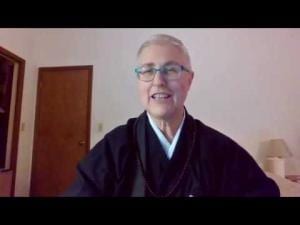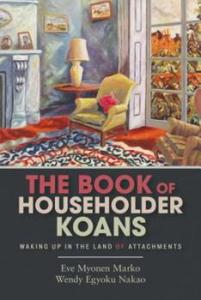Practicing With Householder Koans
Dharma Talk given on March 19, 2021
at the Empty Moon Zen Inaugural Zoom Sesshin
by the Rev. Janine Seitetsu Larsen
Senior Dharma Teacher with the Empty Moon Zen Sangha, and Resident Priest with Bright Cloud Zen practice groups of Seattle & Woodinville, WA
It is good to be with you today, this first full day of our Empty Moon Zen Spring Sesshin. Zen retreats like this, even on Zoom, and no matter if they are one day, all or part of a week, or much longer, offer a great opportunity to deepen practice. Thank you for making this investment in your practice, and supporting the rest of us and the Maha-sangha of all who practice this ephemeral existence we call “life.”
Along with sitting practice and meditation in its many forms, Zen also embraces the irrational practice of koan introspection. Koans have a unique way of opening us to deeper experience of this thing known as Zen, which is nothing more than engaging honestly and without inhibition in the Great Matter of life and death.
And, because we are human, we tend to try to control and constrain the definition and function of koans. We create koan curricula, for example, such as our own sincere adoption of the Harada-Yasutani koan curriculum. Some passionate koan practitioners have such a devout reverence for koan study that they hold to a rigid orthodoxy about what is a valid koan and what is not, recognizing only the cases of ancient tradition and lineage, given and guided only by authorized and revered koan teachers.
There is, of course, great wisdom in working with an authentic and skilled koan master to guide and offer correction to koan introspection. While direct experience is rightly emphasized in our Zen tradition, I think that with few exceptions – and it’s safe to say none of us here qualifies – the Zen student who is completely self-referential has a fool for a teacher.
Yet koans, these small and powerful pointers to immediate and continually unfolding enlightenment, are all around us, always tapping us on the shoulder or waving wildly at the corner of our eye, and sometimes bonking us fiercely over the head. Still, we often remain completely oblivious to these everyday invitations.
Our Bright Cloud practice groups have a practice of engaging a book study as part of our two-hour Tuesday and Friday practice periods. Our current book is The Book of Householder Koans, subtitled “Waking Up in the Land of Attachments,” by respected Zen teachers and legit Koan masters Eve Myonen Marko, Roshi, and Wendy Egyoku Nakao, Roshi. I recommend it to you wholeheartedly – we have found it revelatory.
Our own Guiding Teacher James Myoun Ford, Roshi, had this to say, in his review of the book:
The only real Zen is the Zen of our actual lived lives. Zen’s koans are stories that take us to where we really live, that show us who we are when we let go of the false stories we’ve been trapped within. The collections of these true stories, which open our hearts, started in China. And China gave us many that we cherish to this day. Others came from Korea and Vietnam and Japan. And now, in The Book of Householder Koans, we are given a selection collected from four Western countries by two preeminent American Zen masters. And this is real Zen. These are the true stories of who we have always been from before the creation of the stars and planets. This is Zen made out of our bones and marrow, our tears and laughter. This amazing book is one of a handful written in this time that will be recalled as classics of our way. If you’ve never practiced Zen, read this book. If Zen has been your way for forty years, read this book. It opens our way and reminds us of where to find it. The Book of Householder Koans is a direct pointing to our heart’s longing. True stories.”
So for this morning’s talk, I’d like to share the final Koan presentation in the book and let the co-authors provide the dharma talk. This chapter is titled “Nomita Sees the Ancestors,” and it begins on page 260, for those who have the book handy and would like to follow along.
In the style of traditional koan presentation, this chapter like all in the book begins with an introductory verse, then the koan (or “case”) itself, then the Teachers’ reflection on the koan, and finally closes with pointed questions to consider and sit with.
Here is the verse:
Before you were born,
Before your parents were born,
What do you call it?
And the koan:
When Nomita was visiting her sister at the hospital, she passed a stranger in the hospital corridor and saw a long column of his ancestors walking behind him.
“Oh,” she whispered to herself, “each of us is a combination of our ancestors.” Throughout the day, whenever she looked at people, she saw their ancestors walking in an endless column behind them.
And now, the authors’ reflection: (read pg 260-262)
Here are the questions the authors leave us with:
When you look in the mirror, who do you see? Where are the ancestors right now? What are you leaving for others as your spiritual inheritance?
These everyday koans we can treat in the same way we might treat lectio divina. For example, when you read them more than once and you listen first for just the rhythm of of the words. And then you read them again, paying attention to what are the images or the phrases that are catching your attention. And then you read them a third time, and invite them in to sit with you, and teach you and awaken you, and invite you to ask your own questions.
So – with this reading of the Housholder Koan, and with these questions and reflections from the authors, I’ll invite you to consider and share something that this story woke up in you. Maybe like one of those little taps on the shoulder, what was a phrase or image that stuck with you or struck you? What was a question or a story that reminded you of you? What do you think about these final questions.














